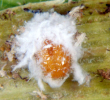Scientific name
Scymnus (Scymnus) nubilus Mulsant (=Scymnus lateralis Sicard)
Taxonomic position
Coleoptera: Coccinellidae: Scymninae: Scymnini
Diagnosis
Length 1.75-2.20 mm, width 1.30-1.65 mm. Form oblong oval, dorsum moderately convex. Head dark brown, lighter in males. Pronotum dark pitchy brown to black in middle, anterior and lateral margins reddish brown and lighter. Scutellum dark brown. Elytra yellowish to reddish brown, with a dark brown to
black sutural stripe starting from basal margin and gradually narrowed towards apex, lateral borders narrowly dark brown to black at middle. Ventral side reddish to yellowish brown, except pro-, meso- and metasterna and middle of abdominal segments dark brown. Prosternal intercoxal process with carinae (Fig.
2) posteriorly divergent. Postcoxal line (Fig. 3) incomplete, running parallel to posterior margin to nearly 3/4 th of its length and then gently recurved, area enclosed coarsely and densely punctate. Male genitalia (Figs. 4-6) as illustrated. This species is very similar to S. (Neopullus) hoffmanni in general appearance and coloration and can be differentiated by the 11-segmented antenna, incomplete femoral line and the male genitalia.
 Figs. 1-6. Scymnus nubilus: 1. Antenna; 2. Prosternal intercoxal process; 3. Postcoxal line on abdominal ventrite 1; 4-6. Male genitalia: 4. Tegmen, ventral view; 5. Tegmen, lateral view; 6. Sipho Figs. 1-6. Scymnus nubilus: 1. Antenna; 2. Prosternal intercoxal process; 3. Postcoxal line on abdominal ventrite 1; 4-6. Male genitalia: 4. Tegmen, ventral view; 5. Tegmen, lateral view; 6. SiphoImages


 Adult Adult
 Pupa on sorghum leaf Pupa on sorghum leaf
Distribution
India: Commonly distributed throughout the country (Karnataka; Kerala; Goa; Haryana;
Maharashtra; Orissa; Punjab; Rajasthan; Tamil Nadu; Uttar Pradesh; West Bengal). Nepal. Pakistan. Bangladesh. Myanmar. Japan. Micronesia. Asia Minor. Mediterranean region. Africa (Booth & Pope, 1989; Canepari, 2003).
Prey / Associated habitat
HEMIPTERA: Aleyrodidae: Aleurodicus dispersus Russell, Aleurolobus barodensis (Maskell), Neomaskellia andropogonis Corbett. Aphididae: Aphis craccivora Koch, Aphis gossypii Glover, Aphis nerii Boyer de Fonscolombe, Pentalonia nigronervosa Coquerel, Rhopalosiphum nymphaeae (Linnaeus), Therioaphis trifolii f. maculata (Buckton). Pseudococcidae: Birendracoccus (as Pseudococcus)
saccharifolii (Green), Coccidohystrix insolita (Green), Maconellicoccus hirsutus (Green), Pseudococcus corymbatus Ramakrishna Ayyar. DIPTERA: Cecidomyiidae: Contarinia sorghicola (Coquillet). Thysanoptera: Caliothrips indicus (Bagnall) and Thrips
tabaci Lindeman. ACARI: Oligonychus coffeae (Nietner) on tea; Oligonychus (as
Paratetranychus) indicus (Hirst) on sorghum. Commonly found feeding on aphids, mealybugs, thrips, and mites on maize, sorghum, finger millet, cowpea, mulberry, cotton, guava, groundnut, brinjal, onion, banana, sandal, Phaseolus mungo, etc.
Seasonal occurrence
Present throughout the year. Active during January-May (Puttarudriah & Channabasavanna, 1956), and July-August in South India.
References
- Bielawski, R. 1972. Die Marienkafer (Coleoptera: Coccinellidae) aus Nepal.
Fragmenta Faunistica, 18, 283-312.
- Canepari, C. 2003. Coccinellidae (Insecta: Coleoptera) of Nepal from the collection of the Naturkundemuseum Erfurt, pp. 261-265. In: Biodiversity and natural heritage of the Himalaya
(Hartmann, M. & Baumbach, H., Eds.). Verein der Freunde & Foerderer des Naturkundemuseums Erfurt e.V.
- Johnson, J. 1972. Biology of Scymnus nubilus Muls. (Coccinellidae: Coleoptera), an insect
predator. Agricultural Research Journal of Kerala, 10, 183-185 (published 1973).
- Pang, X. & Gordon, R.D. 1984. Lectotype designations and new synonymy in Oriental Scymnini (Coleoptera: Coccinellidae). The Coleopterists Bulletin, 38(2): 131-135.
- Puttarudriah, M. & Channabasavanna, G.P. 1953. Beneficial coccinellids of Mysore-I. Indian Journal of Entomology, 15: 87-96.
- Puttarudriah, M. & Channabasavanna, G.P. 1956. Some beneficial coccinellids of Mysore. Journal of the Bombay Natural History Society, 54: 156-159.
- Santhakumar, M.V. & Chakraborty, N. 1997. Biology of Scymnus nubilus Mulsant (Coleoptera:
Coccinellidae), a native predator of pink mealy bug, Maconellicoccus hirsutus (Green) (Hemiptera: Pseudococcidae). Journal of Entomological Research, 21: 329-334.
|